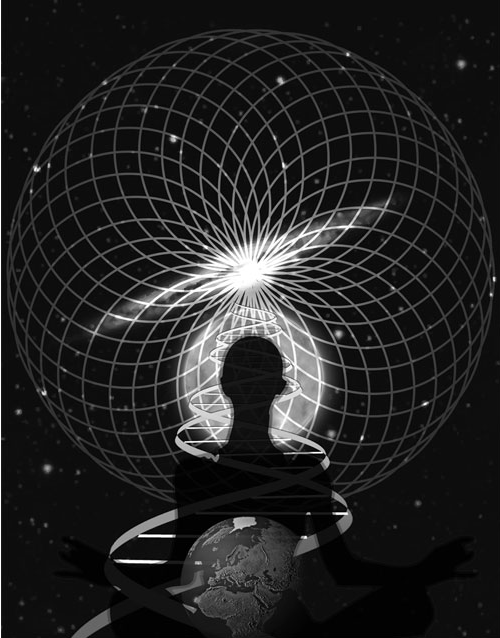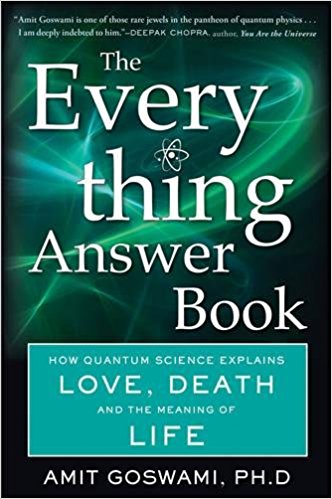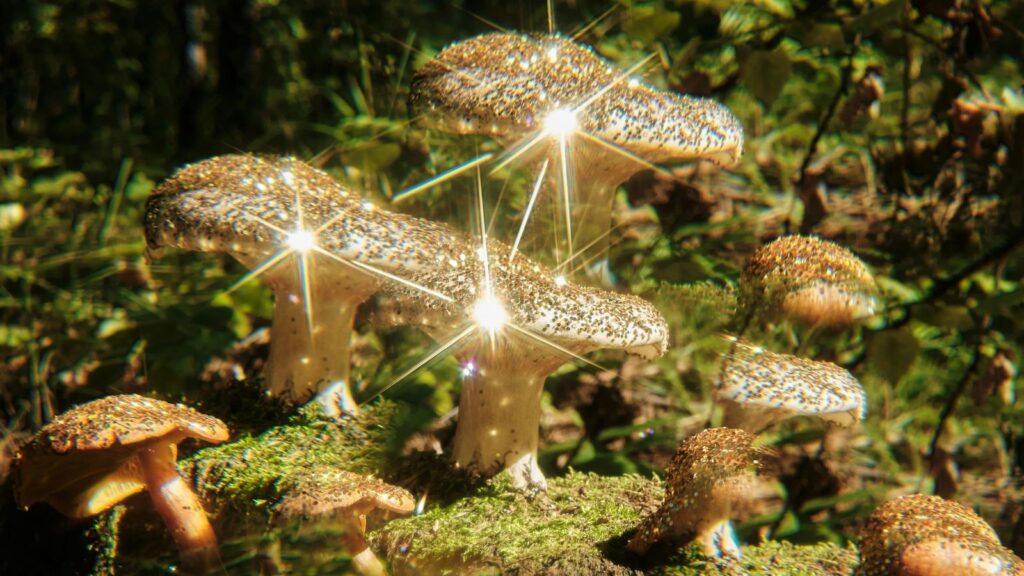The following is excerpted from The Everything Answer Book: How Quantum Science Explains Love, Death, and the Meaning of Life by Amit Goswami PhD, published by Hampton Roads Publishing.
Zen Buddhism contains many parallels to quantum physics in the way it introduces the basic ideas of spiritual duality— heaven and earth, transcendent and immanent. For example, in Zen, there are two domains of reality—the domain of emptiness and the domain of form. The wave-particle theory of quantum physics recognizes two similar domains—the domain of potentiality and the domain of actuality. Likewise, consciousness plays a role in both realms in quantum physics, as it does in Zen, as shown in this parable:
Two monks are arguing. One says, “The flag is moving.”
The other says, “No, the wind is moving.”
A master, passing by, admonishes them both: “The
flag is not moving; the wind is not moving. Your mind
is moving.”
As stories like this show, students of Zen are often puzzled by their spiritual domains in the same way that students of quantum physics are puzzled when first confronted with the separate domains of the quantum world. Indeed, physicist Niels Bohr once famously said:, “If you are not puzzled by quantum physics, you can’t possibly understand it.” It is the same in Zen, whose students achieve understanding through a creative awakening. The discipline of quantum physics is not just a bunch of information to be learned. It is a way of looking at the world in which we discover the deeper implications of a new para-digm—one that gives us an awakening into the nature of reality itself.
Simultaneous Opposites
In the Zen way of thinking, opposites can exist simultaneously; contradictory things can exist at the same time, as revealed in this story:
A master is teaching two disciples; a third disciple is sitting a little farther away, listening. One disciple expresses his understanding of what the master is teaching. The master says, “Yes, you are right.”
The other disciple, in his turn, gives a completely different interpretation of the teaching. Again, the master says, “You are right.”
Both students go away satisfied. The third disciple confronts the master, saying, “Master, you are getting old. How can they both be right?”
The master looks at him and says, “You, too, are right.”
Quantum physics works in a similar way. For every proposition, the opposite can also be true, because we always have this opposition of concepts being forced upon us by the nature of objects. For example, one of the very first teachings of quantum physics is that a quantum object can be both a wave and a particle. But waves spread out; they can be at two or more different places at the same time. Particles, on the other hand, behave differently. They can only be in one place at a time, and they always travel in a single definite trajectory.
In our everyday lives, we often face similar contradictory options. We want to make a decision—to choose—but we cannot because we also want to keep all options open. Quantum theory let’s us do just that. We can keep all options open in potentiality, while making a decision—a choice—to collapse one potential into actuality. In psychotherapy, the domain of potentiality that contains all options at the same time is called the unconscious. More and more psychotherapists are realizing the value of the unconscious in therapy, finding that, when people allow their unconscious mind to process their choices, they are more satisfied with the result.
The important thing to recognize is that quantum physics is built into the nature of reality. When quantum physics says an object is both a wave and a particle, this is not a teaching tool or a metaphorical statement. It is really the case. For a long time, this was not clearly understood. Quantum theory was taken simply as a way of describing reality to make it more easily understandable. But this is not the case. Quantum physics is, in fact, a new way of recognizing quantum objects that is leading to many breakthroughs in many fields.
For example, take the case of wave-particle duality. When we say that an object is both wave and particle, we are not saying that an object is both wave and particle in space and time, in this very manifest space-time domain of reality. Instead, we are saying that the wave-ness of an object is true in a domain of reality that is beyond space and time—a reality that is unmanifest. We are saying that there is a domain of reality beyond space and time, a domain we call the domain of potentiality. In the domain of potentiality, the object is a wave of potentiality, or possibility.
The Domain of Potentiality
This domain beyond time and space is not only similar to consciousness; it is consciousness. This conceptual breakthrough came soon after experimental data showed that there is a way to distinguish, experimentally, between the domain of potentiality, where objects are waves of possibility, and the domain of actuality, in which objects are particles. French physicist Alan Aspect and his collaborators created an experiment that proved that this domain of potentiality has a unique, defining characteristic—communications that occur there do not require any signals, any mediation. The implications of this finding are astounding. For if communication can occur instantaneously and unmediated in this domain, it follows that the domain itself is just one thing. It is a continuum of interconnected stuff.
Here, we are communicating through words; I have written some words, and you are reading them using signals in space and time. But we could also be communicating through the domain of potentiality. If I formulate a thought but do not express it verbally or in writing, that thought can still be spread through the domain of potentiality and reach you. Instantly. This is what happens when we are inspired by an author’s words or an artist’s images to create a new thought or feeling. The written or spoken words, or the images, act as a trigger for a nonlocal connection that results in something entirely different.
In Zen Buddhism, we find riddles like this: What is the sound of one hand clapping? This riddle encapsulates the idea that things are born out of potentiality. Any thought is a potentiality with many meanings before it becomes an actual thought with one unique meaning. And in that potentiality, the possibility wave of that thought has many facets. The conversion of potentiality into actuality converts a many-faceted thought or object into a one-faceted thought or object—converts a wave into a particle.
Most of us tend to think that consciousness exists because there are human beings. According to the quantum explanation, however, consciousness already exists in the domain of potentiality, whether human beings are there or not. In fact, that is the whole point. But remember, this domain manifests. So we find that the manifestation of consciousness as self-awareness happens at the same time that thoughts or objects convert from waves into particles.
In this domain of potentiality, there is no form. Form is manifested in a specific way when a possibility is chosen and collapsed into actuality—manifest reality. So if we knew how to manifest a specific form in a specific way in the space-time domain—as a three-dimensional reality—we would be able to solve problems and actualize what we want in this reality. But this would require that we be able to sense or feel whatever the correct possibility is in the domain of potentiality.
And sometimes all we have is a feeling. We may have an intuition about what it is in the domain of potentiality that we want to manifest, but the domain of potentiality has many possibilities. So we have an opportunity to process all these various possibilities and their combinations simultaneously—an entire gestalt—in order to get an answer to the problem at hand.
This is where Zen and quantum physics converge as an approach to the human mind. Both Zen thinking and quantum thinking are based on allowing two levels of thought. By contrast, thought in a Newtonian world occurs on only one level. In this one-level world, which exists only in manifest space and time, there is only what we call conscious thought. Conscious thought lets us look at various possible answers, but we can only consider one aspect at a time, one facet at a time. When we allow the processing of thoughts to occur, not only in the space-time domain, but also in the domain of potentiality, convergent thinking can process many facets at the same time. The space-time domain is good for generating a whole array of divergent answers; we call it divergent thinking. But to arrive at a solution, simultaneous processing of many possibilities in the domain of potentiality followed by choice—convergent thinking—is more effective.
Now, the processing of thoughts is very different in the domain of potentiality. In space-time, we are conscious; in the domain of potentiality, we are unconscious. Only after repeated bouts of unconscious processing does convergent thinking manifest in the form of a solution—a quantum leap.
Multiple Possibilities
If quantum potentiality can contain multiple possibilities for what we are seeking, it follows that some of these possibilities will be “good” possibilities, and some will not. And of course, we always want to choose “good” possibilities—possibilities that will make things better or change our reality in a constructive way. So how can we be sure to retrieve the particular possibilities that will make for positive change amid all the potentiality?
This is a very good question, although the answer is not very satisfying: There simply is no guarantee. So our creative insights into a problem may have very painful consequences for others. No Japanese person needs to be reminded of the pain that the atomic bomb brought into the world. And yet the scientists who developed it certainly used quantum principles and certainly used Zen thinking. Sometimes, in the immediate aftermath of an event, it may seem as if creativity can lead to evil as well as good. But when we consider evolution—and we will—we see that temporary evil is sometimes necessary to get to the eventual good—to eventual progress through evolution. As painful as it may be for any Japanese person to remember Hiroshima and Nagasaki, the incidents did show us the horrors of atomic war and may have saved us from an even more devastating atomic war in the future.
And this applies to our personal lives as well. For instance, we enter into situations that may be challenging or difficult. But these are often the times when we can break through and reach the next stage in our personal growth. I am reminded here of another Zen story:
A Zen master had the habit of holding up his forefinger, a habit that was often mocked by a certain little boy. One day, the boy held up his forefinger in imitation, and the master witnessed the act. He seized the boy and, using a sharp knife, chopped off the offending finger. When the boy cried out in agony, the master called out the boy’s name to get his attention and held up his forefinger. The story goes that the boy attained enlightenment in that moment.
This story used to bother me a lot. It took me a long time to realize that its moral was that the boy just needed a jolt to move him to a new level in his personal growth. What seems like an evil is sometimes necessary to shake us out of ignorance and put us on the path to growth. Sometimes, unless we suffer, we never make that quantum leap into a better reality. In the same way, a dreadful disease can also be an opportunity to experience quantum healing—to make a quantum leap in emotional thought to heal ourselves by correcting faulty meaning processing (of feelings) and reactivating the immune system in full health. If we are ready, the same quantum leap can be a leap into enlightenment.
In the Zen tradition, students go through five days of very strenuous meditation, which causes a lot of pain in the knees. This pain can make students temporarily lose focus and let their minds wander. But once they have done the practice a few times, they learn to relax when the pain comes. The result is an alternating practice of doing and being—focused attention and relaxation—what I call do-be-do-be-do, after the Frank Sinatra lyric. After these five days, the students go into the presence of the master and experience satori, a quantum leap. Another Zen story considers this transformation:
A group of Buddhists shared a spiritual practice of running around a mountain for one thousand days. But there was a certain monk who gave up after only a few hundred days. The others concluded that he must have been inspired and received a realization on the spot.
Creativity
The Zen path to sudden enlightenment was shrouded in mystery for a long time. But the mystery is resolved when we consider the quantum process of creativity. According to most people, creativity is work. Many people, and most scientists, think that all creative ideas are discovered because of the clever use of the so-called scientific method: Try it and see. Moreover, they try to glamorize the idea by claiming that, because scientists try and see, the process of verification is the crucial approach to creativity. But researchers have found that this is a very inefficient way of finding answers to really difficult and ambiguous questions, because there are just too many possibilities to try them all and to evaluate them individually. There has to be a better way.
After much research into many case histories, researchers found that something different was really going on. Scientists would work very hard to explore a problem. They would find some answers—some existing hints. And then they would just relax. Just relax. Do nothing. And often their breakthrough ideas sprang from that relaxed state.
A Japanese friend who was a copywriter in a high-powered advertising firm described some of his colleagues as more or less laid back, easygoing people. But he discovered that those seemingly easygoing, laid-back people seemed to be able to explore creativity much better than his busy, uptight colleagues. And that’s the message of field research into creativity. Creativity not only requires the focus of driving intensity, which most people do have today but also requires a relaxed being—an unfocused mind. These are the two stages of the creative process: preparation and unconscious processing. Do-be-do-be-do.
Although researchers have known this for quite some time, no one could explain why it was so. When quantum physics and its proper interpretation came along, we found the explanation very easily. Between events of choice, quantum objects spread, because they are waves of possibility. Just as when you throw a pebble in the water, quantum waves of possibility literally expand and become bigger and bigger pools of possibility from which you can choose. Thus there is an advantage to waiting before choosing, because, if you choose quickly, the pool of possibilities from which you choose will be small. But if you wait—if you relax—that pool of possibilities will be considerably larger, and that is obviously a tremendous advantage for your creativity.
Of course, if you wait too long, you may simply lose your focus on the problem at hand. So there also has to be some sense of urgency that takes us to creative insights. That is why, when I teach courses that require term papers, I give my students deadlines. And I always encourage them to prepare and relax, but never to write the final version until the deadline is near.
For Better or Worse
In potentiality, there are many possibilities. Some of these possibilities will make things get better; some of them will make things get worse. Of course, we have a tendency only to look for the possibilities that will make things better; we tend to hope that only positive things will happen. In reality, however, it just doesn’t happen that way. Negative things still do happen, in spite of our positive intentions. Perhaps we are inept at making choices; perhaps our intentions are confused. Will this change in the future, as we evolve in consciousness? Will negative things happen less frequently, and positive things happen more frequently as we evolve? My personal feeling is that, although on average that may be true, we will probably still occasionally need to actualize something negative in order to arrive at something positive later on.
The negative creates an urgency that generates intensity, which, in turn, spurs our creativity. Suffering creates motivation. Remember the boy who lost his finger. Of course, it would be nice if we could stimulate creative exploration through healthy curiosity alone. Unfortunately, however, in our present state of evolution, it is unlikely many of us will be motivated toward quantum creativity or Zen enlightenment by just honest curiosity, without some push forward from suffering. This is why I think, in Buddhism especially, there is emphasis on the recognition of suffering. And life and the world being what they are, I suspect that there will always be trials and tribulations that will spur us on to growth.
It is important to recognize that we can respond to crisis situations and negative events in a way that can promote more positive outcomes. Armed conflicts, global climate change, and political and economic problems can all be looked upon as danger signs that can prompt opportunities to create a new reality. We can look at a world full of problems and see it as an opportunity to make a creative quantum leap forward to a new worldview. In a worldview based on quantum principles and Zen wisdom, all things are possible—literally possible. From such a platform, we can make quantum leaps—discontinuous leaps of thought from potentiality to manifest actualities that have never been manifested before—to solve problems in physical and mental healthcare, in business, in politics, and in the environment.
Women seem to be better at this kind of leap than men. They are open to higher emotions; they are in their hearts. Likewise some cultures—like those of North India, Japan, Brazil, or Italy—are, in general, less logical and more emotional. This doesn’t mean that they don’t think logically, only that they tend to de-emphasize logic and think in a way that is more or less formless, more akin to potentiality. These cultures are ripe for quantum activism. When we mix the head and the heart, reason and emotions, we transcend both. With quantum creativity, we can resolve all kinds of conflicts and pave the way for a better reality.
As we try to make a quantum leap into this new reality, we will need both logical and nonlogical elements, emotions and intuitions. We will need to focus on feeling and intuition as well as on the mental and the logical. Zen and yoga flourished in America just as these practices were waning in Japan and India, and these disciplines present us with a way of thinking in which we can create a cloud of unknowing before we take the quantum leap to wisdom. Acknowledging this cloud of unknowing is an endeavor that will require intuitions and emotions to guide us. But we will also have to focus; we will have to bring conscious rational effort into the process of creativity. It will not be an easy process, nor will it be a quick one.
Let me close with yet another Zen story:
A student had just finished fourteen years of awareness training. One rainy day, his Zen master invited him to his house for a celebratory dinner. As the student arrived, he put down his umbrella, took off his shoes, and went inside. The master welcomed him and asked, “Did you bring an umbrella?”
“Yes, Master, I did,” said the student. “You also took off your shoes, I see. Very thoughtful.” “Thank you, Master.” “Now tell me, on which side of the umbrella did you
leave your shoes—the left or the right?” The student could not remember. “Master, I am not aware,” he said. “Well, fourteen more years of training for you,” said the master.
***
















